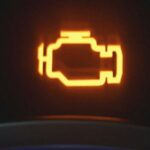
12 Jul Why is My Check Engine Light On? Common Causes
 The check engine light is a small warning sign on your dashboard. It indicates something is wrong with your vehicle’s engine or emissions system. But what exactly does it mean when that light comes on? There are various reasons for a triggered check engine light, from a faulty gas cap to a defective catalytic converter. This blog post will explore common causes your check engine light may be on.
The check engine light is a small warning sign on your dashboard. It indicates something is wrong with your vehicle’s engine or emissions system. But what exactly does it mean when that light comes on? There are various reasons for a triggered check engine light, from a faulty gas cap to a defective catalytic converter. This blog post will explore common causes your check engine light may be on.
Check Engine Light Common Causes
Understanding the common causes can help you make an informed decision and seek professional assistance when needed.
Loose or Faulty Gas Cap
A loose or faulty gas cap is a common cause of an illuminated check engine light. Failing to tighten the gas cap properly could result in fuel vapors escaping from the gas tank, triggering the light. Luckily, simply tightening or replacing the gas cap if it is damaged may solve the issue.
Oxygen Sensor Malfunction
The oxygen sensor measures the oxygen levels in the exhaust system, ensuring optimal fuel efficiency and reducing emissions. A malfunctioning oxygen sensor can result in a lit check engine light. Replacing a faulty Oxygen sensor helps to maintain engine performance and pass emissions tests.
Defective Catalytic Converter
The catalytic converter decreases harmful emissions from your vehicle’s exhaust system. An old or defective converter can lead to poor engine performance and reduced fuel efficiency, triggering a dashboard warning light. If you suspect a catalytic converter issue, it’s best to have it diagnosed and replaced.
Faulty Mass Airflow Sensor
The mass airflow sensor measures the air levels entering the engine, helping the computer determine the appropriate amount of fuel to inject. A faulty sensor can cause a too-rich or too-lean fuel mixture, causing the check engine light to go on. Replacing a bad sensor can restore proper engine function.
EGR Valve Problems
The Exhaust Gas Recirculation (EGR) valve recirculates some of the exhaust gas back into the engine to reduce nitrogen oxide emissions. A malfunctioning EGR valve can cause engine knocking, decreased fuel economy, and increased emissions. Cleaning or replacing the valve may be necessary to resolve a check engine light issue.
Spark Plug or Ignition Coil Issues
Spark plugs and ignition coils are crucial for your engine’s combustion process. Worn-out spark plugs or faulty ignition coils can result in misfires, reduced power, and increased fuel consumption. Any of these issues could contribute to a dashboard warning light.
Responding to a Check Engine Light
Remember, the check engine light is a warning signal that something is amiss with your vehicle’s engine or emissions system. If your check engine light comes on while driving, it’s important not to panic. If the light is blinking or the engine is struggling, find a safe place to pull off the road and exit the vehicle.
- Check for any obvious issues, like a loose gas cap.
- Call AAA or other automotive roadside assistance if you have it.
- If the problem remains unresolved, tow it to an auto service center for service.
- If the car feels safe, continue to drive it home and immediately schedule a diagnostic test with your mechanic.
AAA-Approved Auto Service For Check Engine Light
Remember, regular vehicle maintenance and inspections help keep your engine running smoothly and can avoid dashboard warning lights. Plymouth Auto & Tire Center is a AAA-approved auto repair facility. This program only approves facilities that meet the highest standards in vehicle repair, competency, reliability, cleanliness, overall experience, and fair pricing.
Schedule Diagnostic Service
The highly trained technicians at Plymouth Auto & Tire Center will gladly address all your Check Engine Light issues. Call us at (610) 825-6558 or visit us online to schedule service today!

